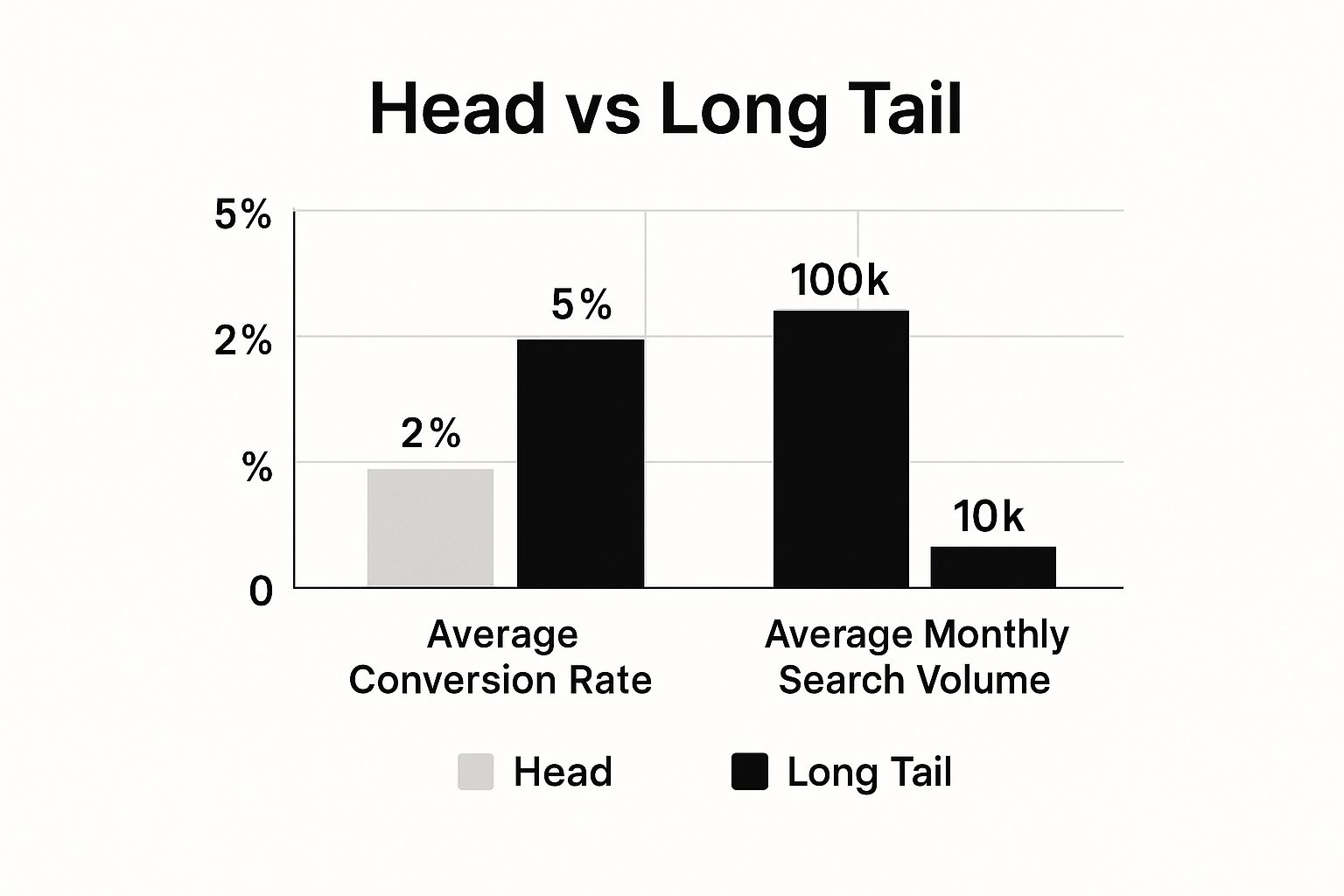
Long Tail Keyword Research: Your Complete SEO Strategy Guide
Sections
#Understanding Long Tail Keywords (And Why They Matter)
Think of a busy market. Shouting “shoes” is like using a generic keyword – you reach many, but few are truly interested in your specific offerings. Long tail keywords, on the other hand, are like a focused conversation. They address specific needs, attracting highly qualified potential customers.
This precision is the core of effective long tail keyword research.
#What Exactly Are Long Tail Keywords?
Long tail keywords are longer, more specific search terms, usually three words or more. They pinpoint exactly what a user wants. Instead of just “coffee,” someone might search for “best organic coffee beans for French press.” This tells you not just what they want (coffee beans) but how they’ll use them (French press) and their preferred qualities (organic, high-quality).
This detail changes the game for businesses.
Long tail keywords usually have lower search volume, but they attract users further down the sales funnel, closer to buying. This results in significantly higher conversion rates. Because of this high conversion potential and reduced competition, long tail keywords have become a vital part of successful SEO strategies. Traditionally, these longer phrases have been seen as containing three to five words, zeroing in on a user’s specific search intent. By the early 2020s, long tail keywords already drove approximately 70% of all search traffic. For more detailed statistics, check out this guide: Long-Tail Keywords: The Essential Guide for SEO Success
#The Power of User Intent
Understanding long tail keywords depends on understanding user intent. A long, detailed Google search tells you exactly what someone wants. This information is gold for businesses, letting you create content that addresses precise needs and offers targeted solutions.
Long tail keywords also often reveal users’ questions. For example, “how to clean a coffee maker with vinegar” shows someone actively looking for a solution. Answering these question-based searches positions your content as helpful, building trust and establishing your authority in your niche.
Learn more here: The Magic of Keywords: How to Optimize Your Site for a Wide Range of Search Queries
#From Search to Sale: The Long Tail Conversion Journey
Long tail keyword research isn’t just about finding words; it’s about understanding the customer journey. Targeting keywords at different stages of the sales funnel lets you guide potential customers from initial research to purchase. It’s like a roadmap leading directly to your goal: a conversion.
This targeted approach connects with your audience meaningfully, offering exactly what they need at the right time. Long tail keywords turn casual browsing into targeted conversions, boosting your chances of gaining loyal customers.
#Tools And Techniques That Actually Find Gold
Forget generic keyword lists. It’s time to uncover hidden gems: the profitable long tail keywords your competitors might be missing. We’ll explore methods used by top SEO agencies, combining free Google tools with premium platforms to build a robust keyword portfolio.
#Mining Google’s Hidden Treasures
Google offers a wealth of free tools for long tail keyword research. Autocomplete suggestions are a great starting point, revealing what people actually search for. Observe the variations and longer phrases that appear. Related searches at the bottom of the search results page offer further insights, often uncovering related long tail keywords you might not have considered.
Exploring question-based queries is also crucial. Consider your audience’s perspective: what questions would they ask? Tools like AnswerThePublic can help generate a comprehensive list of question-based long tail keywords. This allows you to create content that directly addresses user needs.
You might be interested in How to Master Search Analytics with Rankdigger for refining your keyword strategies.
#Advanced Techniques for Long Tail Keyword Domination
Beyond Google’s free tools, premium platforms like SEMrush, Ahrefs, and Moz offer advanced features for in-depth long tail keyword research. These platforms provide data on search volume, keyword difficulty, and competitor analysis.
Competitor gap analysis is a powerful technique. Analyzing your competitors’ keywords helps identify long tail opportunities they might be missing. This lets you target underserved niches, potentially capturing a valuable market segment.
Forum mining and social listening are creative avenues for research. Monitoring online conversations helps you identify the language your target audience uses, uncovering valuable long tail keywords.
#Visualizing the Long Tail Advantage
The following infographic shows the differences between head keywords and long tail keywords regarding average conversion rate and average monthly search volume.

While head keywords have higher search volume (100k), long tail keywords have a significantly higher conversion rate (5% versus 2% for head terms). This highlights the power of targeting specific user intent. Focusing on niche searches can lead to more qualified leads and conversions.
#Organizing Your Keyword Arsenal
Effective long tail keyword research involves more than just lists; it requires organization. SEOs group related keywords into topic clusters, creating a structured approach to content.
The following table compares several popular long tail keyword research tools:
Long Tail Keyword Research Tools Comparison
Comprehensive comparison of popular keyword research tools highlighting their strengths for long tail discovery
Tool Name | Best For Long Tail | Price Range | Key Features | Difficulty Level |
|---|---|---|---|---|
SEMrush | Identifying competitor gaps and long tail opportunities | $99-$499/month | Keyword Magic Tool, Competitor Analysis, Position Tracking | Intermediate |
Ahrefs | Discovering content gaps and long tail keywords with low competition | $99-$999/month | Keywords Explorer, Content Explorer, Site Audit | Intermediate |
Moz | Analyzing SERP features and long tail keyword difficulty | $99-$599/month | Keyword Explorer, Rank Tracker, Link Explorer | Beginner |
AnswerThePublic | Generating question-based long tail keywords | Free and Paid versions | Question-based keyword suggestions, Data visualization | Beginner |
This table summarizes the strengths and weaknesses of each tool, allowing you to choose the best fit for your needs. Remember to consider your budget and technical skills when making your decision.
This structured approach helps search engines understand your content and provides users with valuable information. This leads to increased engagement and higher rankings.
#Why Longer Keywords Convert Like Crazy

Long-tail keyword research delves deeper than simply finding keywords. It’s about understanding what motivates searchers. It’s about connecting with potential customers at the moment they’re ready to buy. That’s why a search like “best waterproof hiking boots for wide feet” outperforms a general term like “hiking boots.”
#The Specificity Advantage
Imagine someone searching for just “hiking boots.” They might be browsing, comparing brands, or just starting their research. Now, picture someone searching for “best waterproof hiking boots for wide feet.” This searcher has a particular need. They are likely much closer to making a purchase.
This specificity is the heart of long-tail keywords’ power. These searches demonstrate clear purchase intent. You can target customers who are ready to convert, rather than those still in the early stages of research.
This allows your content and products to directly address a specific need. For example, a landing page optimized for “best waterproof hiking boots for wide feet” can feature waterproof boots in wide sizes, complete with customer reviews and detailed product information. This targeted approach significantly increases the chances of a sale.
#Modifier Words: Turning Browsers into Buyers
Certain words within long-tail keywords act as modifiers, indicating a higher likelihood of purchase. These modifiers often highlight a particular need, preference, or problem a user aims to solve. Words like “best,” “cheap,” “review,” “near me,” “how to,” and “vs.” suggest active evaluation and decision-making.
Long-tail keywords also illuminate your customers’ specific challenges. A search like “how to fix a leaky faucet” presents a clear problem. Content directly addressing this positions your business as a helpful resource, building trust and potentially driving sales of plumbing supplies or services.
The impact of long-tail keywords on click-through rates (CTRs) is undeniable. Studies have shown that long-tail keywords can achieve up to 1.76 times more clickthroughs than very short keywords. Longer phrases, between 10 and 15 words, see even more dramatic results, garnering 2.62 times more clicks than single-word keywords. You can find more in-depth statistics here: Long-Tail Keyword Research Statistics.
#E-commerce Success with Long Tail Keywords
Successful e-commerce businesses understand the power of long-tail keywords. They utilize these specific searches to connect with customers precisely when they’re ready to buy. This translates to thoughtfully written product descriptions, targeted ad campaigns, and highly relevant landing pages.
This focused approach allows businesses to engage with the most qualified leads. This leads to higher conversion rates and increased revenue. It’s about being present exactly when and where your customers are searching for you.
#Capturing Voice Search and Conversational Queries
The way people search online is changing. Instead of typing short keywords, they’re using their voices to ask questions conversationally. This presents a significant opportunity for businesses that understand how to optimize for voice search using long tail keyword research.
#Understanding the Conversational Shift
Voice searches differ significantly from typed searches. People speaking to their devices, like smart speakers or phones, use longer, more natural phrases. You wouldn’t tell Siri “pizza delivery,” would you? More likely, you’d say something like, “Find pizza delivery near me that’s open late.” This natural language is full of long tail keywords.
This shift means optimizing for voice search requires understanding how people speak, not just how they type. It’s about anticipating their questions and providing direct answers in your content. This conversational approach is crucial for attracting voice search traffic.
#Researching Question-Based Keywords
The rise of voice search and Natural Language Processing (NLP) has made long-tail keywords incredibly important in modern SEO. Users interact with virtual assistants like Alexa and Siri using conversational language, often phrasing their requests as long-tail keywords. This aligns perfectly with the specific nature of these longer search terms. Learn more about the relationship between voice search and long-tail keywords.
To capture this traffic, focus your keyword research on questions. Consider the “who, what, where, when, why, and how” questions your target audience might ask. Tools like AnswerThePublic can help generate a list of these question-based keywords. For example, a plumber might target questions like, “How do I fix a leaky faucet?” or “What’s the best way to unclog a drain?”
#Optimizing for Featured Snippets and Position Zero
Optimizing for voice search often involves targeting featured snippets and position zero. These top spots on the search results page are frequently read aloud by virtual assistants answering voice queries.
To secure these positions, structure your content to directly answer the question. Use clear, concise language, and format your answer as a numbered list or table, which search engines often prefer for featured snippets. This strategic approach positions your content as the authoritative response, boosting visibility and driving voice search traffic.
#Understanding Semantic Relationships and User Intent
Search engines are becoming increasingly adept at understanding the meaning behind searches. They consider semantic relationships between words to determine user intent. This means going beyond simply including keywords. You must demonstrate a deep understanding of the topic and provide comprehensive information.
For example, if someone asks, “What’s the best temperature to brew coffee?”, a search engine might also consider related concepts like grind size, brewing time, and coffee bean type. Addressing these related topics in your content shows search engines that you understand the broader context and are providing a truly valuable answer. This holistic approach is vital for ranking well for conversational queries.
#Building Content That Ranks With Long Tail Research

Successful content creators understand the power of long tail keywords. They don’t just find them; they strategically integrate them into a comprehensive content strategy. This involves mapping keywords to the customer journey and building topic clusters to demonstrate expertise.
#Mapping Keywords to the Customer Journey
Think of the customer journey as a funnel. At the top, users are exploring a problem. Their long tail keywords might be informational, like “how to choose hiking boots.”
As users move down the funnel, their searches become more specific, indicating purchase intent, like “best waterproof hiking boots for wide feet.” Mapping your long tail keywords to these stages allows you to create content for each step.
This ensures you’re providing valuable information at the right time, guiding users towards a conversion. For example, a blog post answering “how to choose hiking boots” could link to product pages featuring “best waterproof hiking boots for wide feet,” creating a natural flow.
#Building Topic Clusters for Authority
Topic clusters organize content around a core topic, supported by related long tail keywords. This structure establishes your site as an authority. For example, if your core topic is “coffee,” related long tail keywords could be “best coffee beans for espresso,” “how to grind coffee beans,” and “best coffee maker for home.”
Creating content for each of these long tail keywords, while linking them back to your core “coffee” page, builds a web of information. This interlinked structure signals to search engines your in-depth knowledge, improving rankings.
#Identifying Content Gaps and Opportunities
Long tail keyword research can reveal content gaps where competitors are missing opportunities. By analyzing competitor keywords, you can find underserved niches and create content targeting those specific needs, capturing a new audience segment.
This proactive approach keeps you ahead of the curve. It’s about finding the white space in your market and filling it with valuable, targeted content that addresses a specific user need not met elsewhere.
#Balancing Search Volume and Competition
Prioritizing long tail keywords involves balancing search volume with competition analysis. A keyword with high search volume and intense competition might be difficult to rank for. However, a keyword with lower search volume but less competition could bring valuable, qualified traffic.
Tools like Rankdigger’s Search Analytics can help analyze metrics like Opportunity Score to identify keywords with high potential and less competition, ensuring you focus on keywords that deliver the best results.
#Content Formats and Quality at Scale
Different long tail queries require different content formats. A “how-to” question might be best answered with a video tutorial, while a product comparison might work well as a table. Choosing the right format enhances user experience and improves engagement.
Maintaining quality while scaling content production is crucial. A clear content creation process and style guides ensure consistency, allowing you to create large volumes of content without sacrificing quality.
#Content Mapping Strategy
The following table, “Long Tail Keyword Content Mapping Strategy,” outlines a framework for organizing long tail keywords by search intent and content type for maximum SEO impact. This helps visualize the connection between keywords and content, ensuring a strategic approach.
Search Intent | Keyword Length | Content Type | Competition Level | Priority Score |
|---|---|---|---|---|
Informational | Long (4+ words) | Blog Post, Guide | Low | High |
Investigational | Medium (3-4 words) | Comparison Article, Review | Medium | Medium |
Transactional | Short (2-3 words) | Product Page, Landing Page | High | Low |
By using this framework, you can prioritize content creation, focusing on keywords and content types with the greatest return on investment. This organized approach is vital for successful long tail keyword research.
#Measuring Success and Scaling Your Strategy
Beyond simply achieving high rankings, it’s essential to define the metrics that truly indicate successful long tail keyword research. This involves analyzing conversion tracking, user engagement, and signs of consistent organic growth to understand the impact of your keyword strategy.
#Beyond Rankings: Metrics That Matter
While a good ranking is important, it’s not the end goal. True success lies in conversions. Are your long tail keywords bringing in customers? Tracking conversions, whether they are purchases, sign-ups, or leads, reveals which keywords are truly valuable.
User engagement is another key indicator of success. Are visitors spending time on your site, interacting with your content, and exploring other pages? These actions indicate your content resonates with the audience and keeps them engaged. High bounce rates, however, might suggest a mismatch between search intent and the content you are providing.
Finally, observing long-term organic growth shows the sustainability of your efforts. Are you noticing a consistent increase in organic traffic over time? This signifies your long tail keyword research and content strategy are attracting and retaining your target audience effectively.
#Scaling Your Long Tail Strategy
Managing a large number of long tail keywords can be challenging. Successful SEO teams use organizational systems and automation tools to stay organized. This might include using spreadsheets, keyword management platforms, or even custom-built tools.
Automation can simplify repetitive tasks like keyword tracking and reporting. This frees up your time for more strategic activities such as content planning and competitor analysis. However, even with automation, quality control remains crucial. Regularly review your keywords and content to ensure relevance and effectiveness.
Learn more in our article about Understanding Google Search Algorithm Updates in SEO.
#Overcoming Common Pitfalls
Even with careful planning, long tail keyword strategies can face obstacles. One common pitfall is focusing solely on search volume while overlooking keyword relevance. While high search volume is appealing, it becomes unproductive if the keyword isn’t relevant to your business.
Another mistake is neglecting keyword intent. Targeting keywords without understanding the user’s intent often leads to a mismatch between content and user expectations. This results in high bounce rates and low conversion rates. Finally, failing to adapt to algorithm updates can negatively impact your rankings and traffic.
#Portfolio Management for Long Tail Keywords
Managing a large portfolio of long tail keywords requires a strategic approach. This often means grouping related keywords into topic clusters and prioritizing keywords based on their potential impact.
It’s important to regularly review and refine your keyword portfolio. This ensures your keywords remain relevant to your audience and align with your business goals. This proactive approach maximizes the effectiveness of your long tail keyword research and overall content strategy.
#Maintaining Consistent Performance
Consistent performance with long tail keywords requires ongoing optimization. Track keyword rankings, monitor conversion rates, and analyze user behavior. This data provides valuable insights into what’s working well and what might need adjustments.
Stay informed about algorithm updates and adapt your strategy as needed. SEO is a constantly evolving field, and continuous learning is essential for maintaining long-term success with long tail keywords.
#Drive Organic Growth with Rankdigger
Rankdigger offers a comprehensive SEO platform designed to elevate your organic visibility. From intuitive dashboards and advanced analytics to practical guides and a free Search Analytics tool, Rankdigger empowers you to refine your long tail keyword strategy and drive sustained growth. Explore Rankdigger and unlock your SEO potential.

